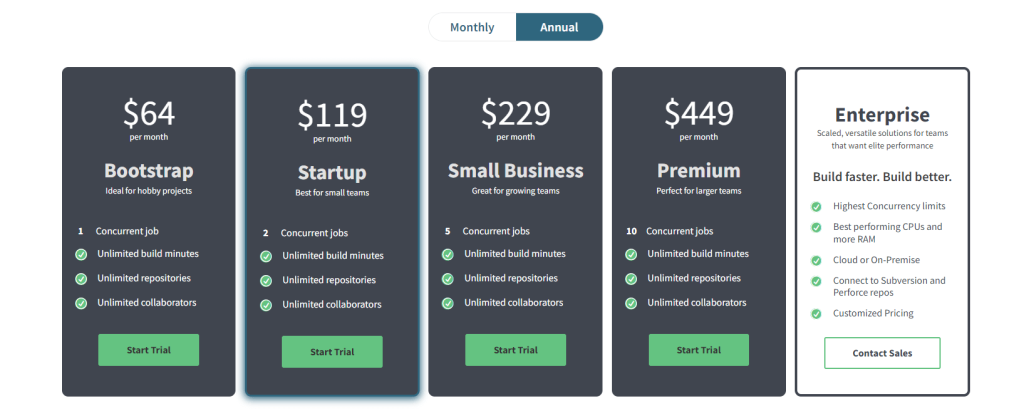Quick List of 10 Alternatives to CircleCI
- Travis CI
- Jenkins
- GitLab CI/CD
- TeamCity
- Bamboo
- Bitbucket Pipelines
- AWS CodeBuild
- Azure Pipelines
- GitHub Actions
- Heroku
CI/CD tools are becoming a fundamental component of DevOps. Using CI/CD solutions, DevOps teams can fully automate the SDLC and STLC phases and release code more quickly, which results in much higher revenues.
CircleCI is one of the most popular CI/CD tools for achieving continuous integration and delivery. This cloud-based tool features wonderful features for automating software development, testing, and deployment.
However, customers are looking for alternatives to CircleCI due to various limitations including complex pricing plans.
Picking out the fitting CI CD tool for your company can be a difficult task as it involves evaluating cost, compatibility, ease of use, and more crucial factors.
To help you choose the right alternative to CircleCI, we’ve compiled a list of 10 excellent CI/CD tools with detailed comparisons to CircleCI.
Overview Of CircleCI & Why People Use It
CircleCI is a popular CI/CD tool founded in 2011 by Paul Biggar and Allen Rohner. The YAML files allow swift and easy configuration of CI/CD into your development architecture.
People love it for offering both on-premise & cloud-based usage and language-inclusive support. Clients can easily log in and execute their builds, tests, and pipelines on the CircleCI Cloud-hosted platform.
Another excellent feature of CircleCI is the reusable orbs that automate repetitive procedures and speeds up the project. Additionally, it can run fast parallel testing on Linux & macOS along with providing Docker support.
Overall, CircleCI is a strong entry-level solution for automating integration and deployment processes.
Reasons To Consider An Alternative To CircleCI
Even though CircleCI is an excellent CI/CD tool, it might not be able to fulfill all the needs of your software company and growing projects. The lack of native governance and the highly complicated pricing plans are two of the main reasons many users are looking for alternatives to CircleCI.
Moreover, as CircleCI is not an open-source tool, there is no organized community support available for this tool. This poses difficulty when developers run into problems while using the tool.
Also, the matter of long queues in case of insufficient containers can become bothersome pretty quickly. On top of that, containers are steeply priced so you can not increase them frequently.
Developers who primarily work in Windows also look for alternatives as CircleCI only supports macOS and Linux.
Brief Overview Of The 10 Alternatives We Will Be Comparing
We’ve picked out the top 10 alternatives to CircleCI. Out of them Jenkins is the only pipeline that’s completely free and open-source. Travis CI, Hereku, and GitLab CI/CD are also affordable compared to CircleCI.
You get the option of both cloud-based and on-premise solutions from Travis CI, GitLab, Bamboo, GitHub Actions, Azure Pipelines, and AWS CodeBuild.
Comparison Chart Of Top 5 CircleCI Competitor
TOOL | Product Type | Set Up & Configuration | Supported Platform | Supported Language | Pricing |
 | Cloud & On- premise | Medium | Linux, Windows, mac | Over 30 languages including Java, JavaScript, Python, C, C++, etc. | |
 | On-premise | Medium | Supports All Platforms | Java, Python, JavaScript, Groovy, Golang, Ruby, C++, and Shell scripts | |
 | Cloud & On- premise | Easy | All Unix OS | Python, Ruby, Java, JavaScript, Vue.Js, Go | |
 | On- premise | Medium | Linux, Windows, macOS | Java, C++, Node.Js, PHP, and more | |
 | Cloud & On- premise | Medium | Windows, Linux, Solarix, macOS | All JVM language including Java, Kotlin, Groovy, Scala |
Best CircleCI Alternatives
1.Travis CI
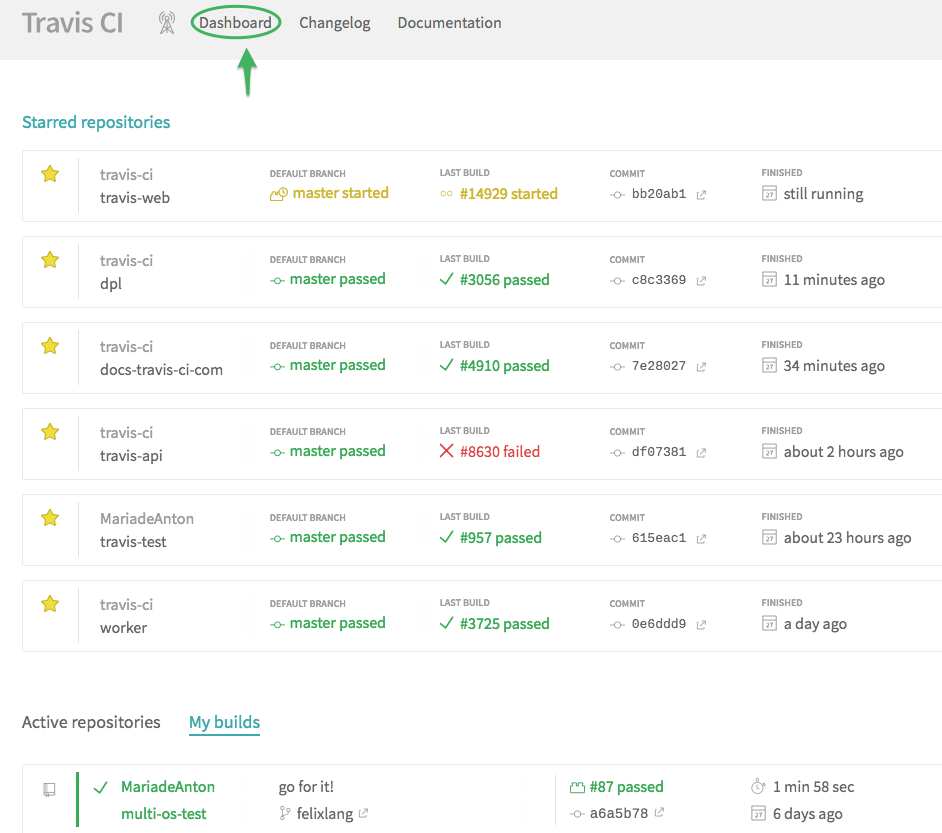
Travis CI is a well-known CI/CD tool and an incredible alternative to CircleCI. This solution can speed up the software development and deployment process with automated testing and a sophisticated alert system.
Travis CI offers cloud-based and on-premise self-hosted services that flawlessly integrate with GitHub and Bitbucket. Customers love it for the enhanced flexibility, privacy, and security it offers.
The ease of use and maintenance makes TravisCI a crowd favorite too. Without having to deal with installation or configuration, you can sign in with your GitHub account, link repositories, and make Travis CI build your projects.
Additionally, for greater scalability, Travis CI supports more than thirty programming languages, including C#, Python, and Java.
This tool can also keep an eye on the entire procedure and send out notifications if something goes wrong.
Travis CI offers free and Enterprise versions for meeting the needs of both small and larger companies.
- Travis CI is based in Berlin, Germany
- Developed by Konstantin Haase in 2011
- Comprises of 30 to 50 employees
- The company earns revenue of over $4 million per year

Key Features
- Compatible with over 30 programming languages
- Auto sync with BitBucket and GitHub
- Parallel testing with build matrices
- Swift deployment on variety of cloud platforms
- Resolve build & deployment issues with SSH troubleshooting
- Supports third-party tools for ensuring code coverage
Is Travis CI Better Than CircleCI? : Travis CI vs. CircleCI
Both CircleCI and Travis CI are cloud-based CI/CD tools for streamlining software integration and deployment.
One of the problems with using CI/CD tools is that the more the project grows the more complicated the pipeline becomes.
Travis CI has an upper hand in this sector as it allows you to split complex scripts and store them as easily maintainable scripts to reduce pipeline complexity. But CircleCI doesn’t offer any such feature.
Another factor where CircleCI lags is that it only supports Read operations while Travis CI API allows you to read & alter the pipeline.
Neither Travis CI nor CircleCI is open source. However, when it comes to community support, Travis CI does offer a more organized helpful community where you’d get better help.
CircleCI container-based service comes with long queue problems which you won’t face with Travis CI as it offers concurrent build-based plans.
Lastly, CircleCI has a steep pricing plan. In contrast, Travis CI offers more reasonable pricing that is ideal for both smaller and larger businesses.
Pros of Using Travis CI
- Seamless GitHub integration
- High flexibility and scalability
- Free for open Git projects
- Easy maintenance and documentation
- Test execution in real environments
Cons of Using Travis CI
- Slows down during heavy traffic
- UI can be confusing
Pricing
Our review of Travis CI
First of all, Travis CI is a more affordable alternative to CircleCI with free pricing for the first 100 builds with all plans.
In addition, Travis CI offers a free subscription including unlimited builds and five concurrent builds for open-source Git projects. So, if you mainly work on open-source projects, definitely go for Travis CI.
Moreover, companies looking for private server solutions can choose the Enterprise plan that allows secure self-hosted solutions.
Another thing we appreciate about Travis CI is the community. It’s better organized, with dedicated support sections for languages, deployment, discussion, feedback, and more.
What’s more, you don’t have to suffer the long queues anymore. Because TravisCI offers concurrent build-based plans with better load balancing and availability.
Overall, Travis CI is an amazing alternative to CircleCI with enhanced ease of use and better pricing.
2. Jenkins

Jenkins is a cross-platform open-source alternative to CircleCI. This Java-based CI/CD tool was one of the first solutions for continuous integration.
Jenkins mainly supports domain-specific languages and offers efficient build automation and CI/CD execution. Using Jenkins is as easy as downloading the war file and running it in your terminal.
Jenkins is compatible with Linux, Windows, macOS, and similar Unix-like environments.
What’s more, this open-source automation tool facilitates integration with hundreds of plugins to support the build, deployment, and automation of your project. These extensions make it incredibly flexible to tailor the tool to your requirements.
With this tool, you can also carry out continuous testing, static analysis, version control, and configuration management.
- Jenkins is based in USA
- Developed by Kohsuke Kawaguchi in 2004
- Comprises of over 100 employees
- The company earns revenue of over $16 million/year
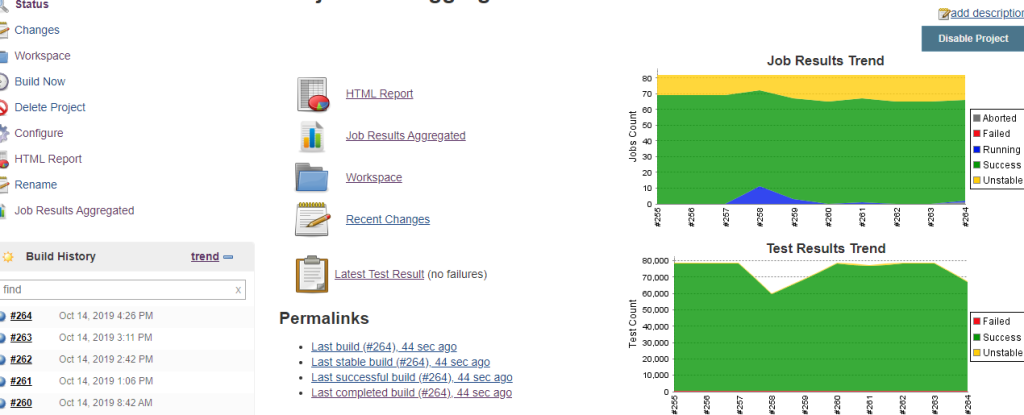
Key Features
- Jenkins is a self-contained Java application
- It offers an ecosystem of over 1500 plugins
- Platform independent extensive internal support
- Supports Google Cloud, AWS, Azure, and Digital Ocean
- Immediate notification about build failure
Is Jenkins Better Than CircleCI?: Jenkins vs. CircleCI
CircleCI is a cloud-hosted CI/CD solution. Unlike CircleCI, Jenkins is hosted locally. As a result, this tool has to be hosted and run on a dedicated server.
To use Jenkins, you must have a competent DevOps team for maintaining the server continuously while CircleCI is maintained by the company.
The aspect that makes Jenkins so popular is that its open source and free to use while CircleCI is a paid tool.
Being open source and over 10 years old, Jenkins has a huge user community and resource availability. You won’t receive such help or resources from CircleCI.
Another aspect where Jenkins tops CircleCI is security. In addition to being hosted on a private server, Jenkins offers various credentials and plugins to encrypt private files, whereas you get limited encryption capabilities with CircleCI.
However, you may be disappointed by the Jenkins UI as it’s slower than the CircleCI UI. The reason behind this is the use of the local server.
Pros of using Jenkins
- Out of the box direct use
- Offers dynamic bug tests
- Completely free & open-source
- High-paced & helpful community
- Numerous plugins with useful documentation
Cons of using Jenkins
- Conflict among plugin versions
- Slows down with user increase
Pricing
Jenkins is an open source CI/CD tool. You don’t have to pay for using it. It is completely free.
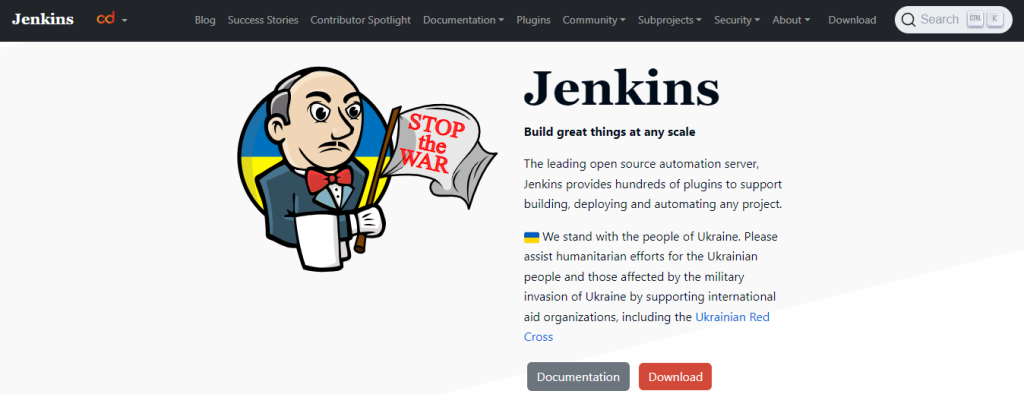
Our review of Jenkins
The fact that Jenkins is a free and open-source CI/CD technology is undoubtedly the first aspect of it that everyone loves. Therefore, small businesses or startups would definitely consider it a great alternative to CircleCI.
Jenkins is hosted on a local server and thus requires you to set up and maintain your own servers. So, consider the skill of your DevOps team when choosing Jenkins.
This Java program provides packages for Linux, Windows, macOS, and other operating systems similar to Unix. Jenkins will therefore work for you regardless of the platform on which you feel most comfortable.
If you work with sensitive or confidential data, Jenkins will be perfect for you. It provides you with a range of credentials and plugins for data encryption and security.
For facilitating a seamless and effective development, testing, and deployment process, this application also provides more than 1500 plugins.
When selecting a CI/CD tool for your organization, community support and resource availability are important considerations and Jenkins has huge community support. So, you’ll get immediate help no matter what problem you are facing.
3. GitLab CI/CD

GitLab CI/CD is essentially a web-based git repository that allows you to automate the entire software development cycle from handling source code and issue tracking to continuous integration, testing, and deployment.
GitLab CI is not a separate tool but a part of GitLab. As a result, you get to access all the wonderful functions in a single interface without the hassle of managing separate tools.
For utilizing GitLab CI/CD, you need a Git repository and a YAML file. These will act as the codebase and define the build, test, and deployment procedures.
Additionally, GitLab CI has an auto-scaling functionality that can automatically spin higher or lower for faster and cost-efficient builds.
That’s not all, it supports builds on many popular languages like Java, PHP, C, and Ruby. Let’s not forget the inbuilt container repository that allows easy storing and sharing of images.
- GitLab CI/CD is a product of GitLab
- Initially developed in Ukraine
- Developed by Dmitriy Zaporozhets & Sid Sijbrandij in 2014
- Comprises of over 1000 employees
- The company earns revenue of over $80 million/per year
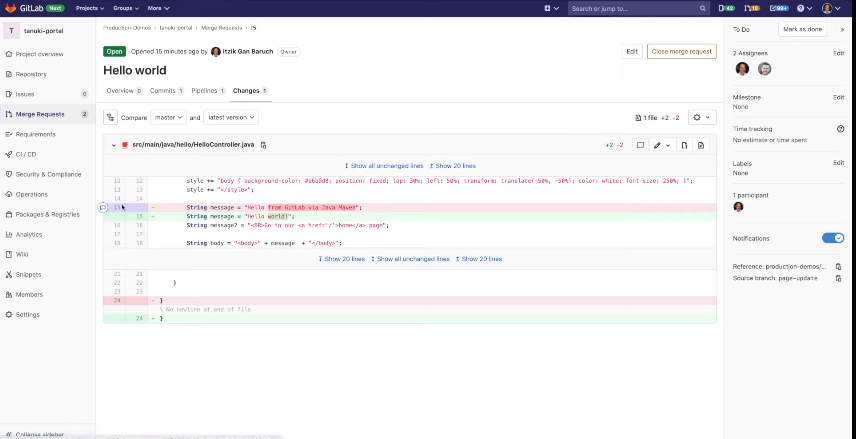
Key Features
- Supports multiple platforms, environments, and languages
- Compatible with BitBucket, GitHub, and other Git servers
- Integrations & plugins for streamlining SDLC
- High security with dependency scanning, SAST, and license compliance
- Autoscaling and parallel builds for faster integration & deployment
GitLab CI/CD vs. CircleCI
CI/CD platforms that natively support hosting services greatly simplify and speed up pipeline management. GitLab CI/CD includes access to GitHub and Bitbucket as well as a built-in Git version control system.
Even though CircleCI offers integration with similar VCS, they are external to the software.
Hence, GitLab makes continuous integration and testing much faster & effortless. Additionally, GitLab reduces the learning curve because you only need to learn one tool.
Customers love GitLab as the interface is familiar to Git and there is huge community support for GitLab users which CircleCI certainly lacks. It would be quite simple to switch to GitLab if you already work with Git.
GitLab has the additional benefit of being able to integrate with 160+ tools & platforms, as opposed to CircleCI’s access to roughly 50 platforms.
GitLab offers improved security features as well because it gives users total control over code access, whereas CircleCI does not. This feature could be crucial while working with sensitive applications.
Pros of using GitLab CI/CD
- Intuitive web-based GUI
- Advanced security features
- Speeds up pipeline with parallel build
- Cost-effective build with auto-scaling
- Easy transition from other CI/CD tools
Cons of using GitLab CI/CD
- Slow paid runners
- Lacks pipeline tracking analytics
Pricing
Our review of GitLab CI/CD
GitLab is one of the most popular open-source CI/CD platforms today. This tool helps developers in every stage of software development from planning to deployment. It is considered a complete DevSecOps ecosystem.
We loved the familiarity of the interface, built-in hosting systems, and the advanced security features offered by GitLab CI/CD. The widespread community support also makes this tool an excellent alternative to CircleCI.
Advanced features such as auto-scaling runners are also note-worthy. It makes super fast deployment possible for growing companies as it can automatically scale to meet build needs.
Another useful feature is test coverage visualization which allows you to check how much test coverage your current test suite is offering at any time.
Even though GitLab is competitively priced, there are options for start-up, medium, and larger enterprises. Choose the option that best suits your requirements.
4. TeamCity

The appeal of the TeamCity CI/CD platform is that it can be customized to suit a variety of development processes. With TeamCity, you can easily set up and maintain the pipeline without writing any code.
This CI/CD solution can integrate with several build and test technologies to help you quickly find and correct pipeline issues. Additionally, it can keep a detailed history of tests for further usage.
TeamCity aids in build activities such as source code compilation, executing unit and integration tests, deploying built executables, and more.
That’s not all, it can integrate with a wide range of version control systems and other platforms. You can use TeamCity’s feature-rich platform to follow the protocols that work best for your team and your organization.
- TeamCIty is developed by JetBrains
- First launched in 2006
- Comprises of over 1900 employees
- Earns revenue of over $200 million/per year
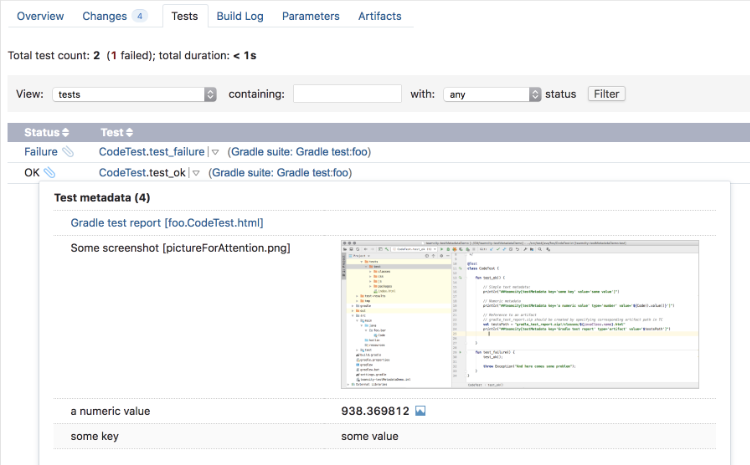
Key Features
- Project-level cloud profiles
- Provides pre-tested and remote-run commits
- Advanced code quality tracking
- Supports wide range of version control systems
- Compatible with .NET, Java, Ruby, iOS, Android, and more
TeamCity vs. CircleCI
The first difference between TeamCity and CircleCI has to be that TeamCity only offers on-premise support while CircleCI provides a cloud product too.
While the cloud server has benefits, on-premise solutions do offer more security and complete control over the code base.
Unlike CircleCI, TeamCity allows you to define pipelines with Kotlin-based DSL. This brings benefits like templates for CI/CD activities and detailed integration with various IDEs.
Additionally, TeamCity provides cutting-edge support for containers and docker, whereas CircleCI’s docker support is obsolete and causes queue issues.
TeamCity introduces advanced features such as build chains. This allows you to create builds with codes distributed across many repositories without worrying about connecting different parts of the pipeline.
That’s not all, features like test intelligence & real-time reporting make continuous integration, testing, and delivery more efficient than ever before, none of which you’ll find in CircleCI.
Pros of using TeamCity
- Ensures improved code quality
- High customization & extensibility
- Maintains CI pipelines health
- Dynamic build progress analytics
- Efficient status monitoring
Cons of using TeamCity
- No pipeline visualization
- Upgrading is complicated & time consuming
Pricing
Our review of TeamCity
JetBrains’ TeamCity CI/CD tool has been loved by the DevOps community since its launch. It comes packaged with so many incredible features that it’s hard not to love!
TeamCity is best known as an intelligent CI/CD server for its in-depth technology awareness with support for automatic version detection, code coverage, testing framework support, code analysis, and more.
Plus, you don’t have to install any plugins or modify any build scripts to get all this support!
Moreover, TeamCity offers features for reusing code and builds to prevent duplication and saves the waste of time & effort. This tool acts as your 24/7 build engineer.
That’s not all, it allows you to generate & maintain high-quality code with the help of code analysis tools like ReSharper and IntelliJ IDEA.
Overall, TeamCity is a premium continuous integration tool for businesses that don’t mind spending a little more for ensuring product quality and enhancing productivity.
5. Bamboo
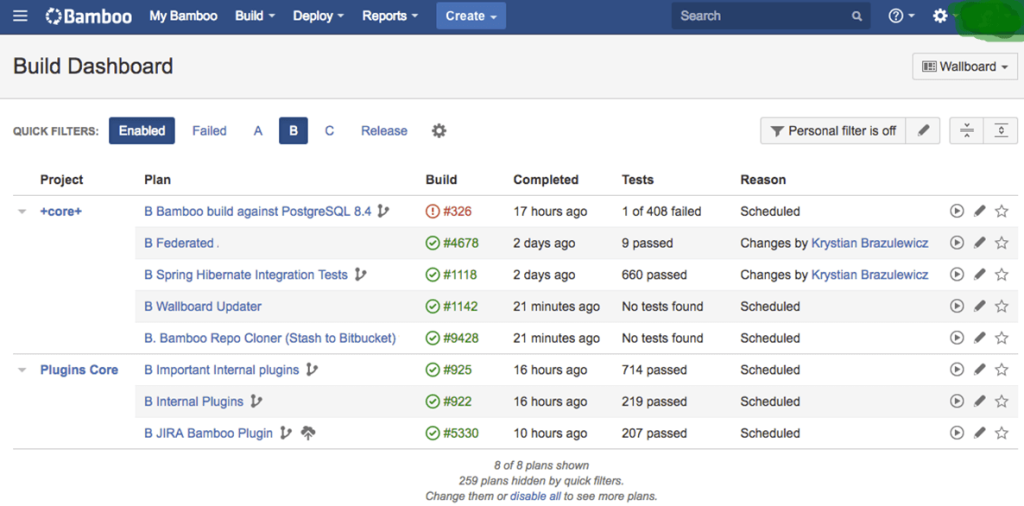
LambdaTest is best known as a cross-browser testing tool for web applications that runs in the cloud. It enables testing across over 2000 browsers, operating systems, and devices. LambdaTest supports both manual and automated cross-browser testing.
With LambdaTest, you can test your web application across the most popular web browsers, including Chrome, Safari, Firefox, Edge, Internet Explorer, Opera, and Yandex.
It is a scalable testing platform that will help your team by moving your software evaluation needs to the cloud infrastructure.
You can ensure that your web application or website is compatible with almost every browser and device on the market by performing real-time cross-browser compatibility testing with LambdaTest.
Furthermore, it allows organizations to test their web application for responsiveness and capture full screenshots while doing so.
LambdaTest is also a cloud-based Selenium Grid that supports all browsers and operating systems. As a result, there’s no need to download or install browsers on your local machine. You can test for cross-browser compatibility in the browser on the cloud with LambdaTest selenium grid.
To detect bugs in web applications, you don’t need to purchase a third-party management tool with LambdaTest. The LambdaTest tool’s built-in issue tracker allows you to efficiently manage the identified bugs. The LambdaTest Console makes it simple to manage the bugs.
LamdaTest’s exceptional features also include online browser testing, selenium testing, cypress testing, HyperExecute, on-premise selenium grid, and native mobile app testing.
- Bamboo was first launched in 2007
- Developed by Australian company Atlassian
- Comprises of over 8000+ employees
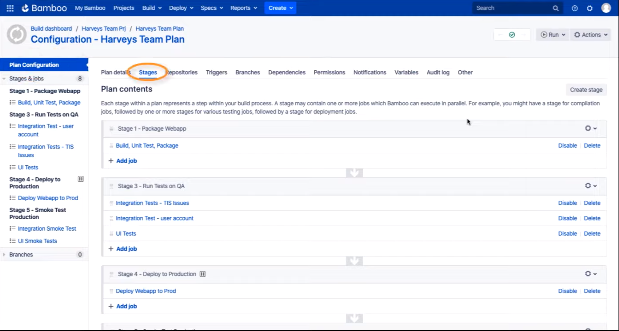
Key features
- Built-in Jira and Bitbucket integration
- Integrated Git branching workflows
- Efficient disaster recovery system
- Compatible with many command line tools
- Easy deployment with AWS code deploy & Docker
Bamboo vs. CircleCI
Bamboo and CircleCI differ in several aspects starting with the fact that Bamboo charges users based on build agents while CircleCI charges based on containers.
Bamboo offers superior support for the delivery aspect of CI/CD. Unlike CircleCI, Bamboo provides fine-grained control to developers over each deployment environment with per-environment permission.
Another factor where Bamboo wins over CircleCI is visibility. Because Bamboo provides end-to-end visibility into the pipeline via built-in JIRA, Bitbucket, and HipChat tools.
CircleCI docker support is quite outdated and faces tons of performance issues. But Bamboo’s intelligent Dockers make it possible to build images, run containers, and push Docker images all inside the project.
That’s not all, Bamboo offers out-of-the-box automated Git branching, unlike CircleCI. CircleCI doesn’t offer any unlimited storage facility on the on-premise version but with Bamboo, you can avail of Amazon S3 unlimited storage.
Pros of using Bamboo
- Scalable cloud platform
- Outstanding integrated debugging
- Locally hosted web testing
- Precise geolocation testing
- Selenium & Cypress testing
- Inbuilt issue tracker
Cons of using Bamboo
- Sharing between builds is difficult
- Limited dashboard support
Pricing
Our review of Bamboo
Bamboo is most known for having built-in integration with the tracking software Jira. It also includes built-in Git branching for automatic branch detection, building, testing, and merging. This way Bamboo streamlines the process of merging Mercurial and Git branches.
Additionally, Bamboo includes advanced deployment support that enables continuous build delivery to test environments and releases builds to customers as soon as the build is ready.
Bamboo does have a decent size community support forum under the Atlassian community for any help that you may need. However, Bamboo doesn’t offer any cloud version which can be disappointing for some users.
There are about 200 Bamboo plugins on the Atlassian marketplace for enhancing your CI/CD pipeline whenever you need them. Last but not least, the Bamboo interface is not only simple to use and intuitive, but it can also be tailored to your specific needs.
Frequently Asked Questions – FAQs
Who Are CircleCI Competitors?
The main CircleCI competitors are Travis CI, Jenkins, GitLab CI/CD, TeamCity, and Bamboo.
Is Jenkins Better Than CircleCI?
Jenkins is better than CircleCI in some aspects. While Jenkins is reliable and secure, CircleCI is lighter and easier to use. However, Jenkins being free to use makes it better in terms of affordability.
Is CircleCI Free For Open Source?
CircleCI is free for open source projects when using the Free cloud pricing option. With the Free plan, open source projects get access to up to 30,000 credits per month.
The CircleCI tool itself, however, is not open source. However, some of its parts, such as Circle doc and Circle orbs, are open source.
Why Use CircleCI Over GitHub Actions?
CircleCI offers several advantages over GitHub Actions such as SSH access to builds for better troubleshooting ability. Developers also get greater visibility in the entire continuous integration & delivery system with CircleCI.
Considering these factors, CircleCI is used by many developers over GitHub Actions.
Conclusion
When it comes to choosing the best CI/CD alternative to CircleCI, there is no predetermined golden rule. One tool that brings success to a company might not be suitable for your needs at all.
All the CI/CD tools we’ve discussed are excellent alternatives of CircleCI. Now, it’s your turn to perform an evaluation of the tools from both a technical & financial standpoint.
Overall, Jenkins would be a perfect starting point if you are just dipping your toes into CI/CD pipelines because it is free yet packed with great features. Looking for a more matured & secure version of Jenkins? Go for Travis CI.
On the other hand, if you have the cash to spend and want to ensure the best CI/CD pipeline with premium features, pick TeamCity.
Read More
Top Incident Management Software
- 5 Best DevOps Platform and Their Detailed Guide For 2024 - December 26, 2025
- Top 10 Cross Browser Testing Tools: The Best Choices for 2024 - October 28, 2025
- 5 Best API Testing Tools: Your Ultimate Guide for 2024 - October 26, 2025

